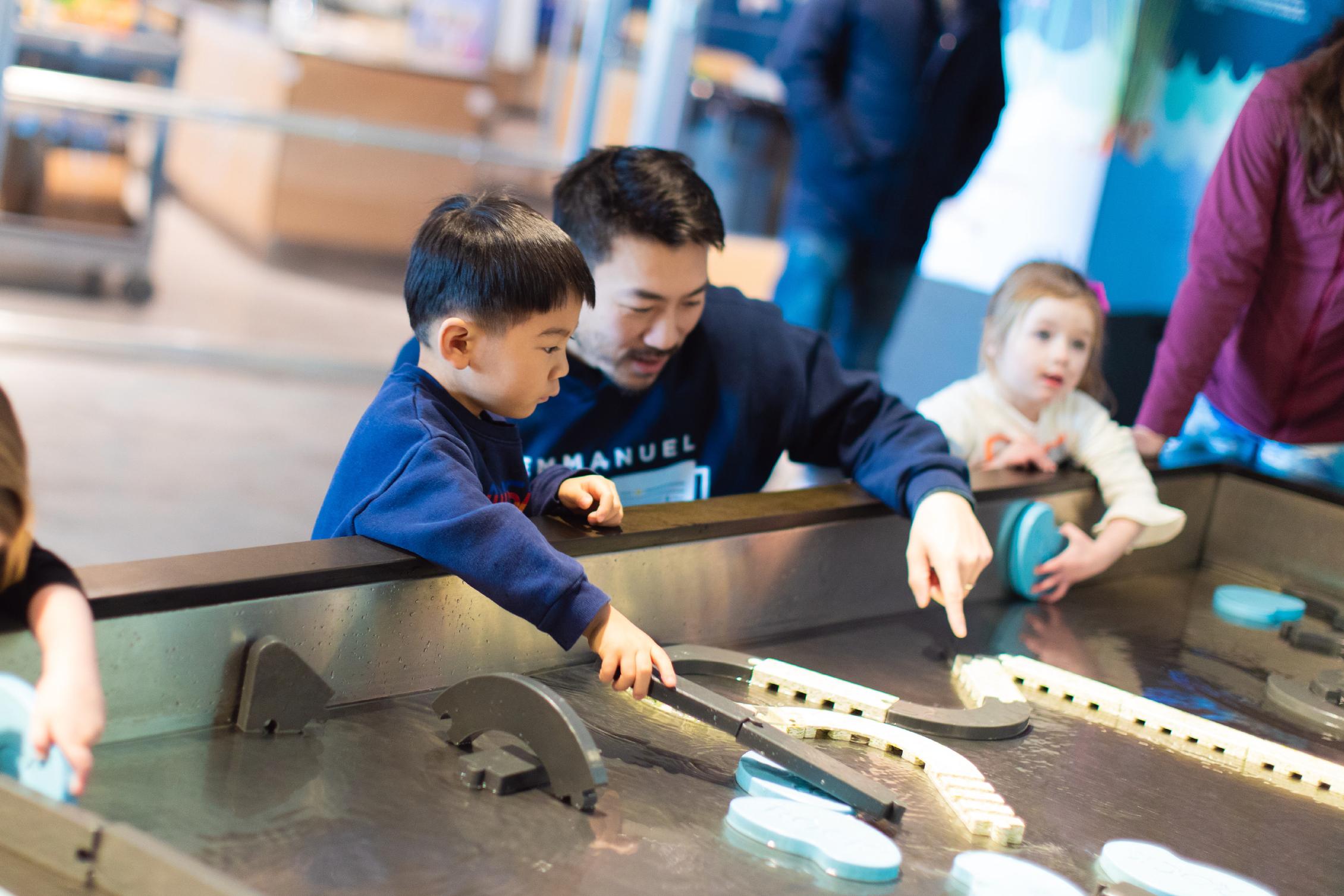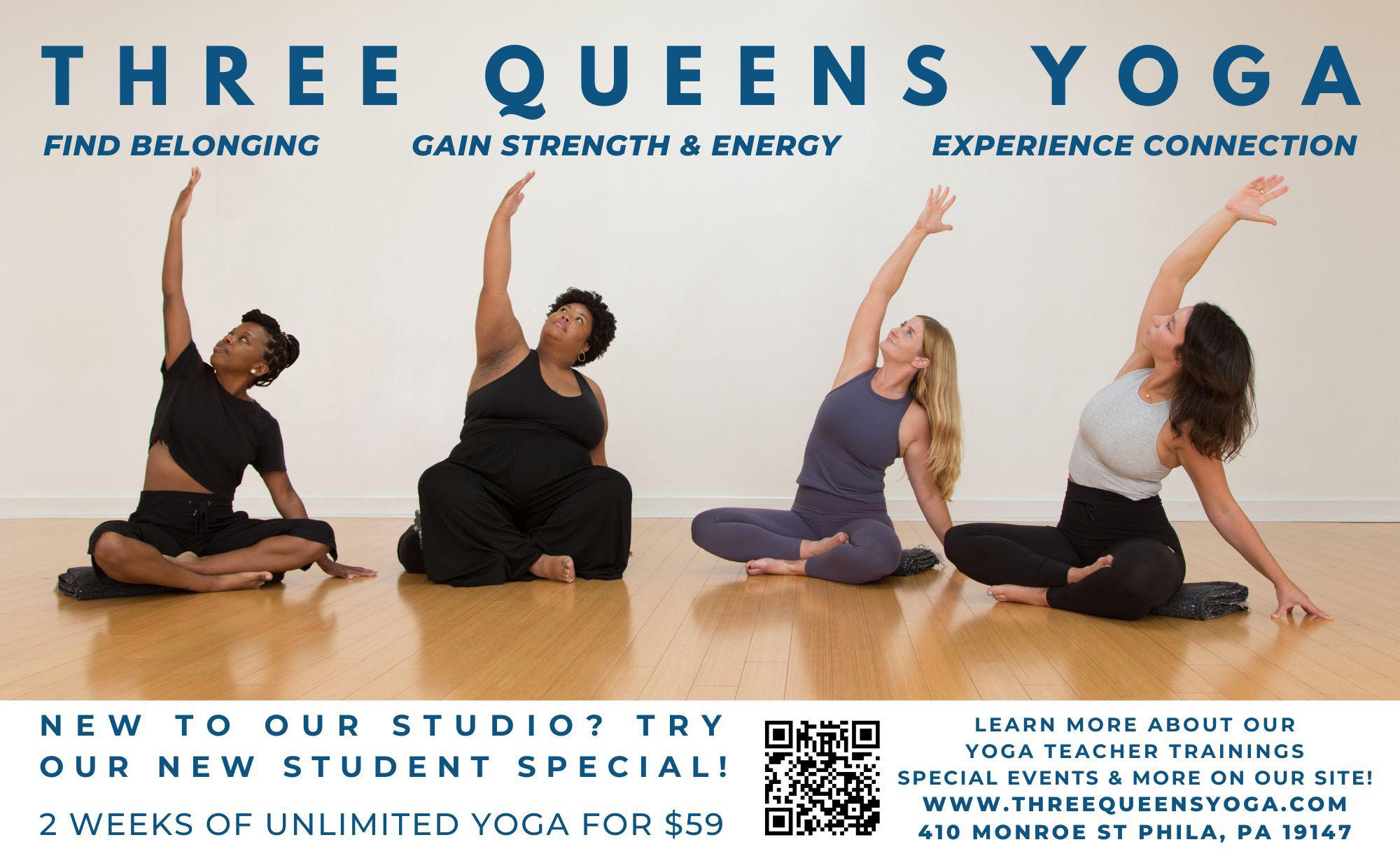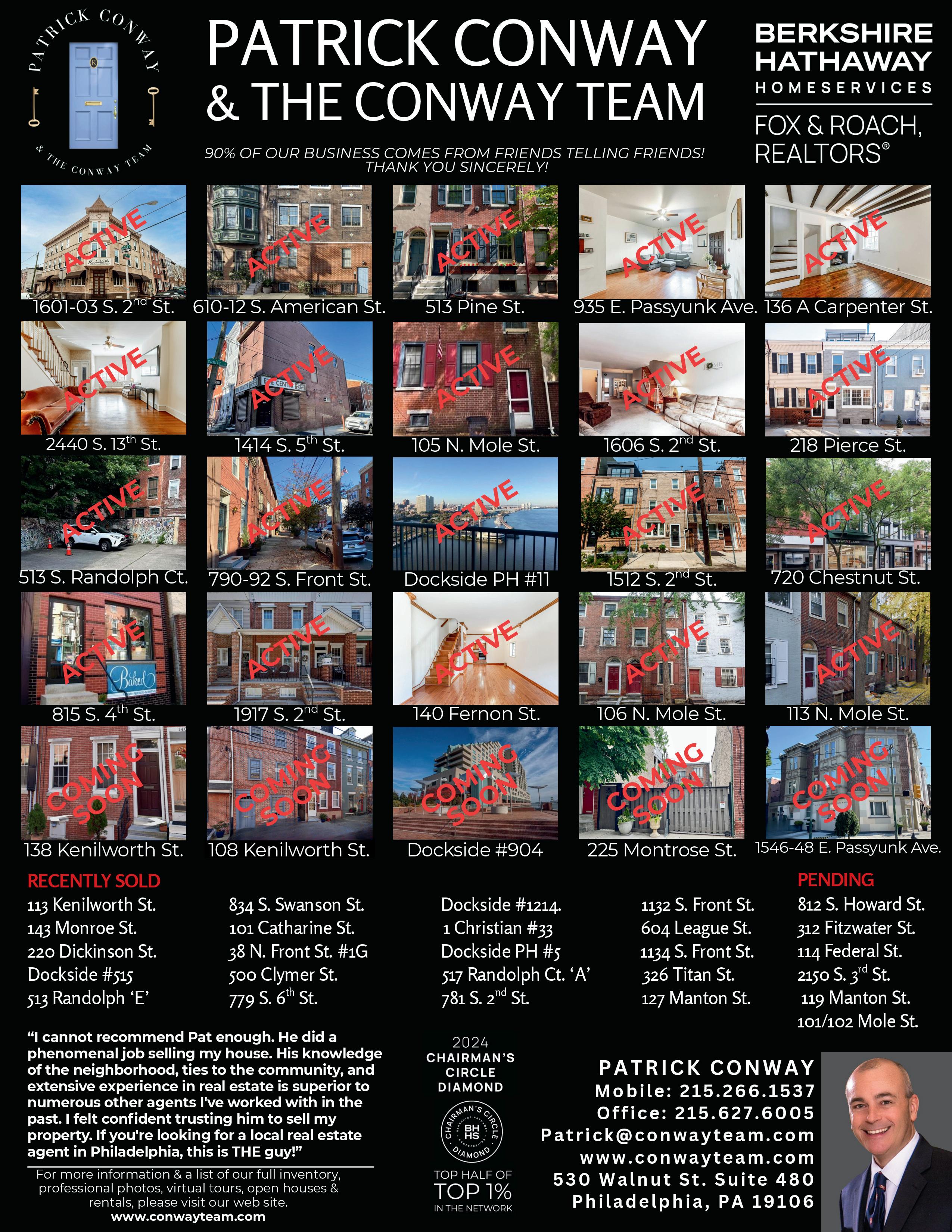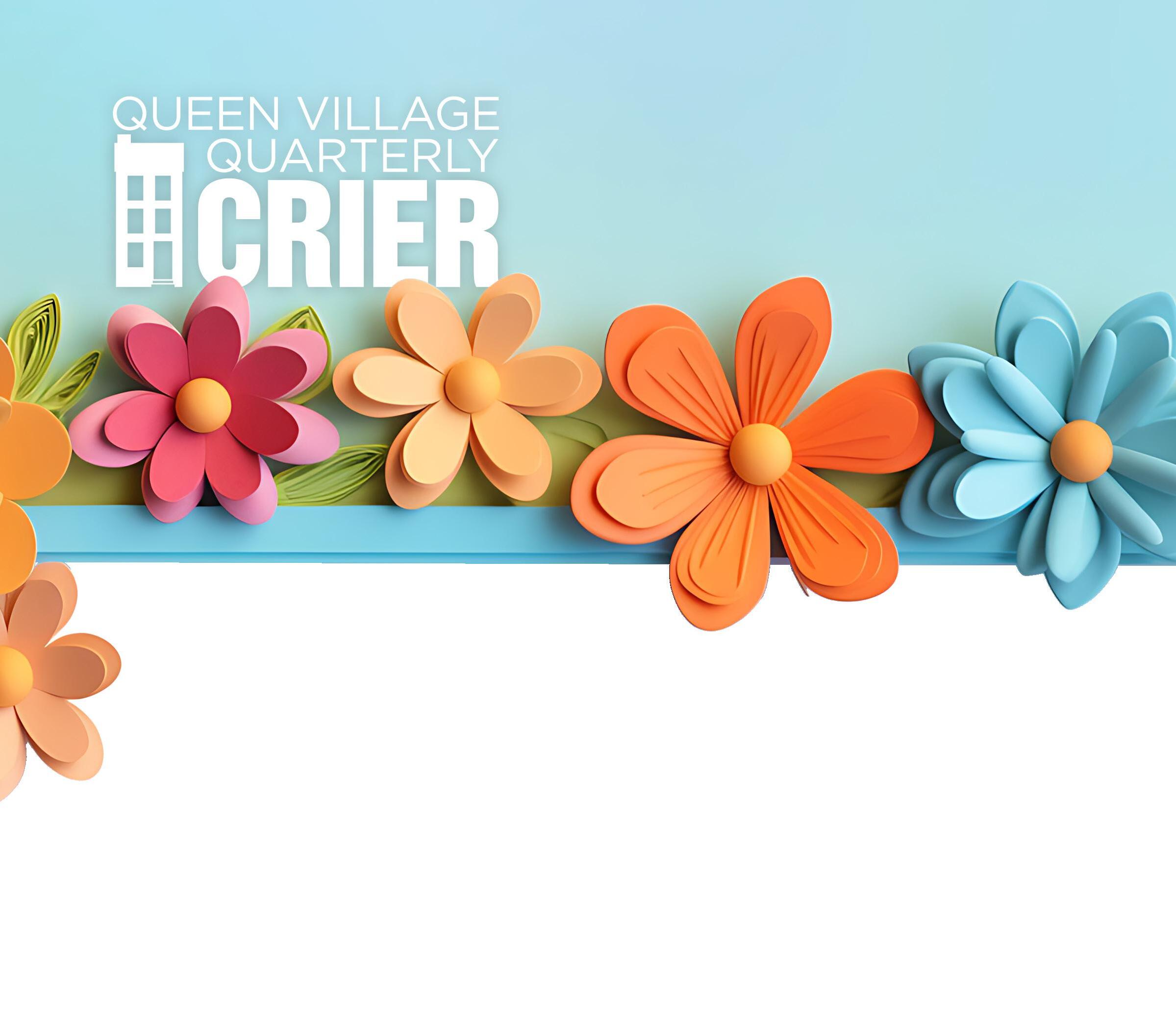
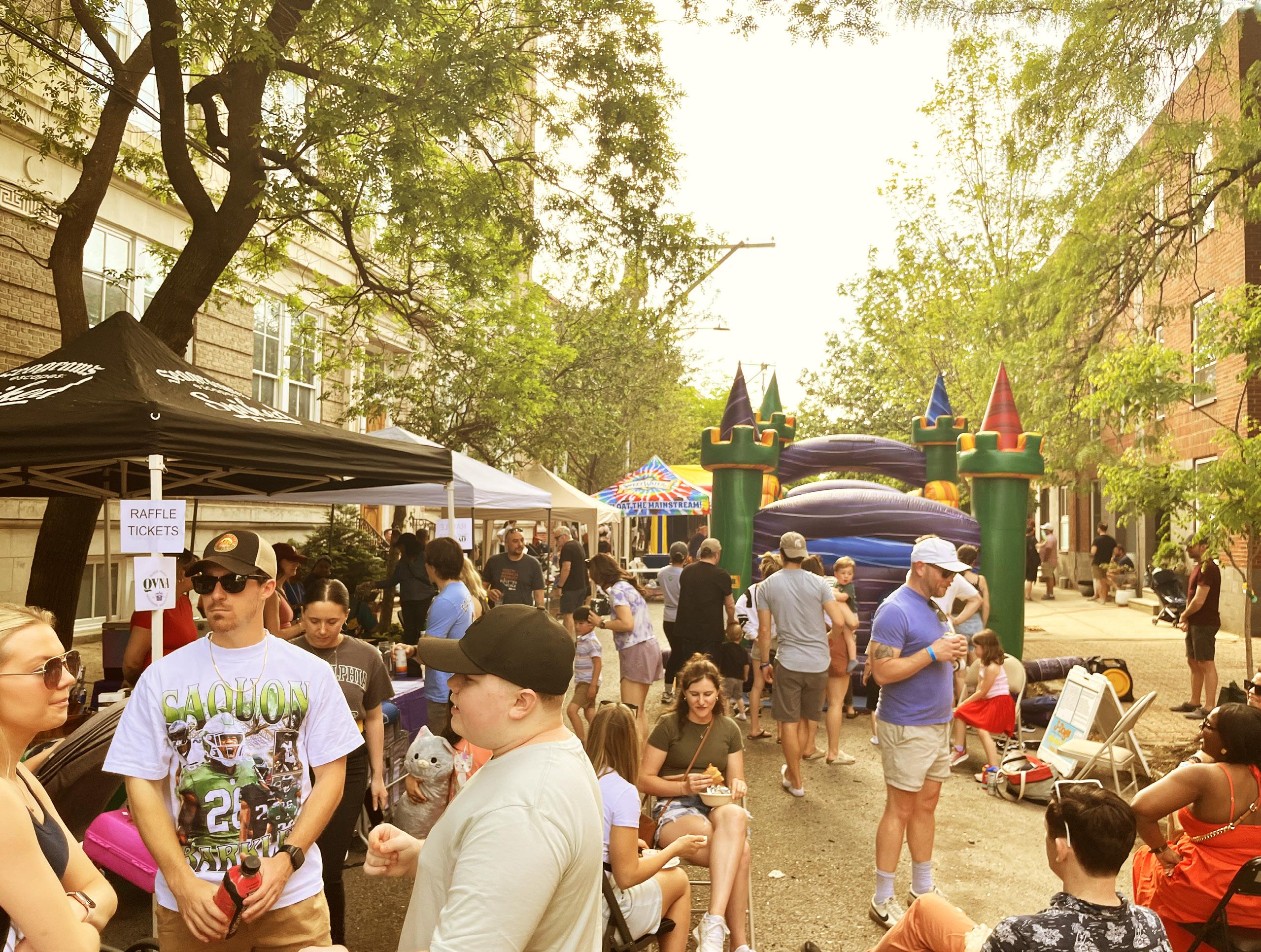




VOLUME 7 | ISSUE 1 SUMMER 2025
PUBLISHER
Queen Village Neighbors Association
EDITOR-IN-CHIEF
Louis Bartholomew louis@qvna.org
DESIGNER
Alec Meltzer meltzerdesign.net
PHOTOGRAPHERS
Maxine Mayer
Dan Lidon
Emily McDonnell
Lisa Mell
Kelly Joyce
PROOFREADERS
Cait Allen
Jake Peterson
AD SALES www.qvna.org/advertise louis@qvna.org
QVNA provides community stewardship, advocacy and service to help improve quality of life for Queen Village residents.

BOARD OF DIRECTORS (2023–2024 TERM)
OFFICERS
Cait Allen – PRESIDENT
Chris Mullen – VICE PRESIDENT
Matt Atkins – SECRETARY
Philip Holzhauer – TREASURER
DIRECTORS
Kevin Farrell
Andrew Jarrah
Mae Johnson
Patricia Kucker
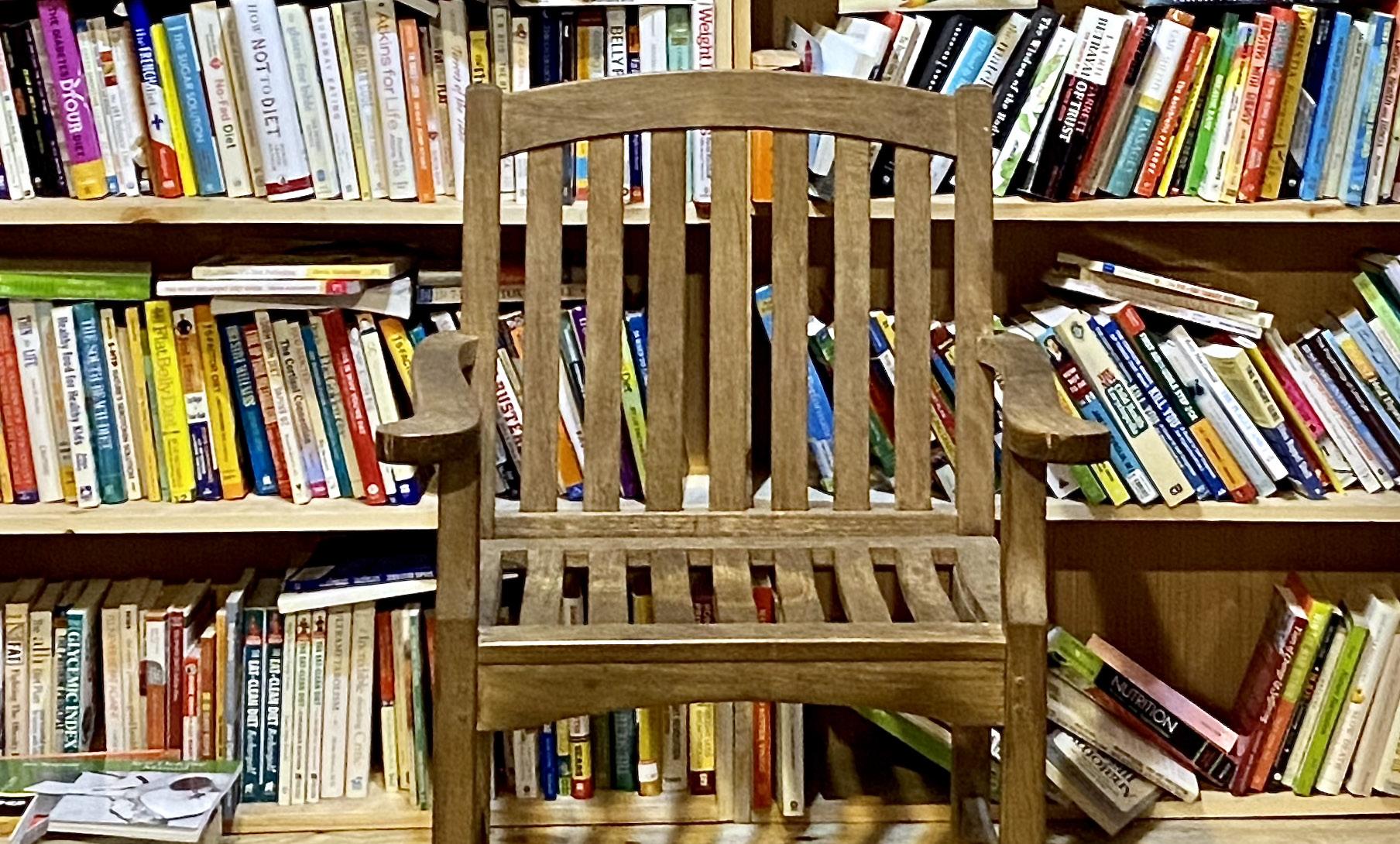
Dennis Mahoney
Amanda Maize Rich Villa Kim Vo
EMERITUS DIRECTORS
Kathy Conway
Inez Green
Michael Hauptman Marian Buczek
QVNA sincerely appreciates the time and talent of the volunteers who helped create this issue of the QV Crier
Daniel Lidon has lived in Philadelphia for nearly 20 years and Queen Village for a decade. He works as a commercial photographer and filmmaker. In his spare time he can be found in Mario Lanza Park with his dog, Ziggy.
Nicole Maley moved here in early 2022 making her relatively new to Queen Village, but already considers it home. By day, she works as a director of media for a New York City marketing agency; by night and on the weekends, she’s an avid walker, amateur historian, and diehard 76ers fan.
Maxine Mayer has been a Queen Villager since 2004. After retiring from a fulfilling nursing career, Maxine pursued her
love of photography volunteering for the Southeastern PA Red Cross and QV Crier. Follow Maxine’s instagram @maxine.mayer.
Emily McDonnell has called Queen Village her home since 2024 after having lived up and down the East Coast. She plans to be a Villager for life. You can find her at the farmers market, picking flowers with her son, Damian, practicing holistic yoga, or enjoying vegan hotdogs at the many no-frills grub spots in the area.
Jack Miller is a relative newcomer to Queen Village. He spends his time away from work reading, writing, and listening to music in various public spots throughout the Village.
Maureen Brady Weir has been a Queen Village neighbor since 2000 and a member of The Friends of Moyamensing Point since 2008. A communications di-
rector by trade, she is also a certified Pennsylvania Master Naturalist.
Hilary Young is a Queen Village mom and owner of Hilary Young creative, a brand strategy and marketing consultancy.
Kelly Joyce has lived on a tiny street in Queen Village since 2012. She is a professor of Sociology at Drexel University where she researches medicine and health. She volunteers with the Tree Tenders to help plant and care for trees in Queen Village.
Cait Allen is the president of the Queen Village Neighbors Association (QVNA), moving to Queen Village in 2019.
Louis Bartholomew is the executive director of the Queen Village Neighbors Association (QVNA). An avid urban planning nerd, coffee shop enthusiast, and architecture buff, he loves working with neighbors to make Queen Village an even greater place to live. ■







Summer is here!
By Cait Allen, QVNA President
Along with the temperature, things are heating up in the neighborhood. So, for this issue’s letter, here are some updates on topics that neighbors have been asking about.
Earlier this year, Councilmember Anthony Phillips passed a bill that directed the Streets Department to add traffic calming measures around Philadelphia schools. One such tool was new speed bumps, which served to slow down traffic and increase safety. Another was the addition of white flex posts at intersections around Meredith School and on 4th Street, a measure called “daylighting.” Daylighting prevents vehicles from stopping and parking illegally near crosswalks. Doing this increases the visibility of approaching bikes, buses, and cars and allows them to see people walking more easily. Daylit intersections lower the chances of
crashes and deaths, a key part of Philadelphia’s Vision Zero agenda. Philadelphia already has laws on the books that prevent stopping and parking within 20 feet of a crosswalk at an intersection, 30 feet of a stop sign, and on crosswalks themselves (Section 12.913.1.b).
Unfortunately, the daylighting installation at these intersections lacked coordination with the neighborhood, including consideration to existing signage, delivery trucks, and handicapped parking spaces. QVNA is working with the Streets Department and Councilmember Squilla to restore the handicap parking and ensure that these intersections are safe for pedestrians, cyclists, and delivery drivers.
A new 157-unit, mixed-use building similar in height to Abbotts Square is under construction at the corner of 5th and Bainbridge, scheduled for completion in early 2027. Many neighbors have asked how this could be built without community input. This is a “by-right” project, meaning that it falls within the allowable guidelines for the parcel, in this case, commercial-mixed use (CMX)-3. The developer does not need any variances or to seek permission from the Philadelphia Zoning Board of Adjustments (ZBA) before beginning construction. The request for a variance is what triggers the normal process to engage the neighborhood.
With Rite Aid filing for bankruptcy earlier this year, Queen Village’s last remaining pharmacy will soon close its doors. Neighbors have put up thank you cards on their interior wall, showcasing how much the store has meant to us over the years. It’s unclear what the fate of the Rite Aid will be. The parcel is zoned CMX-2, which would allow a mixed-use building with residential units on the upper floors and ground-floor commercial space. We hope to see a pharmacy retained in the future!
“Essene’s” is another neighborhood staple that unfortunately shuttered its doors last fall. Despite speculation that another grocer could move in, the space is being converted into a daycare. While many are disappointed to be losing a crucial grocer to 4th Street, the demand for daycare remains strong with many families with young children moving to the neighborhood. Ultimately, it seems that no other grocers were interested in taking over the space, but we hope that changes in the future as we work to attract new retailers to our neighborhood.

Story and Photos by Emily McDonnell
In the heart of Queen Village, nestled on historic Fabric Row, Good Good Chocolates, located at 746 S. 4th Street, is more than just a place to satisfy your sweet tooth—it’s a heartfelt expression of resilience, artistry, and community spirit.
Founded by Lisa Schoenbeck, who hails from Chicago, Good Good Chocolates began as a dream carried coast to coast. Schoenbeck started off in the pastry business, worked briefly in Los Angeles, and then moved to Philadelphia with crates full of chocolate molds and bakery equipment in tow. Her early products—Philly bars, bon bon bars, and s’mores bars—hinted at what was to come. It wasn’t until 2024, though, that she opened the doors of her charming Queen Village storefront.
The journey to get there was far from linear. After landing a space at MaKen Studios in Kensington in 2019, Schoenbeck was immediately faced with two unforeseen challenges: the COVID-19 pandemic and her cancer diagnosis. While she underwent treatment, her husband, Brian, kept the chocolate production afloat, navigating a time filled with uncertainty. That season became a turning point, and when she recovered, the decision to open a shop was both a leap of faith and a celebration of perseverance.
Today, Good Good Chocolates is a bright and whimsical haven for chocolate lovers. The shop specializes in bon

bons—meticulously handcrafted confections that double as miniature works of art. Painted by Schoenbeck herself with tempered cocoa butter, each bon bon takes two days to make and features thoughtfully paired ingredients using Valrhona chocolate, a prized French supplier known for ethical sourcing. The result?
A flavor and visual experience that feels more like edible sculpture than candy.
“It’s exhausting,” Schoenbeck admits, “but I wouldn’t trade it for the world.”
The store has opened up a new kind of joy in her life: daily interactions with customers. Some are locals who stop in af-
ter school or on weekend strolls, others travel from the suburbs for a sweet bite.
A baby whose parents are regulars even took his first steps on the shop floor, a memory now etched in chocolate-coated lore. "Everyone’s happy in a chocolate shop," she laughs.
Schoenbeck’s approach to business is grounded in playfulness and warmth. During my visit, her team was still workshopping names for a new creation, inviting customers into the process with giggles and open-mindedness. The small team includes Kat, a former archaeologist who found her way to Philly—and to
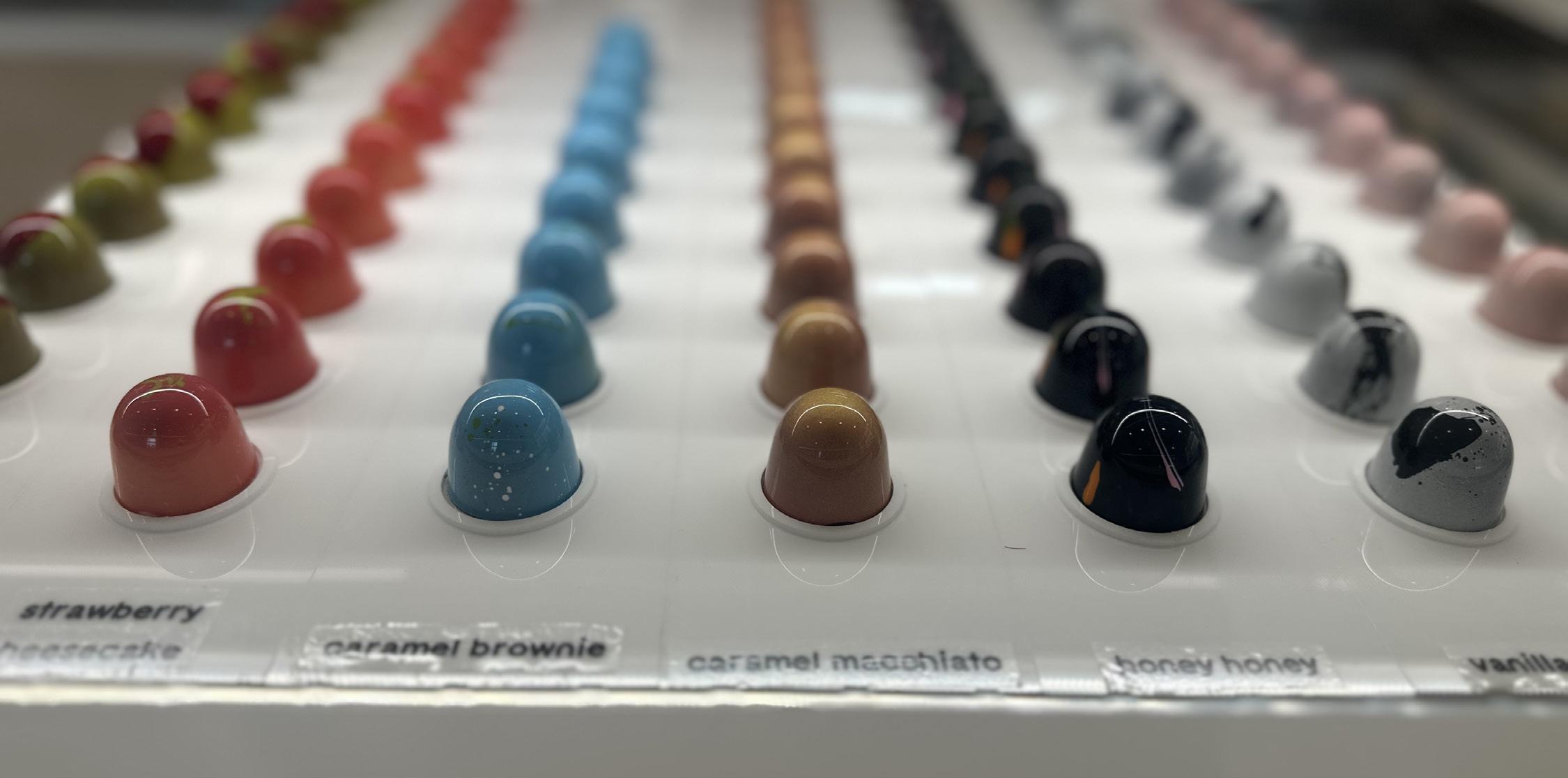
Good Good Chocolates—through a series of life’s curveballs including wildfires, the pandemic, and a hurricane. “It was kismet,” Kat says. “Working in chocolate is a good place to be when you’re having a hard time.”
Good Good Chocolate’s bon bons aren’t just beautiful; they’re technically demanding. Humidity, temperature, and time all play delicate roles, and Schoenbeck has had to master the science behind the shell to maintain her artistic flair. Her mastery was forged by trial and error; while she was still working out of her studio, she learned the necessity of normalizing conditions for the chocolates. She recalled an early collaboration for which she was commissioned by the Philadelphia Museum of Art, inspired by several of their renowned artists. As time went on, she observed small differences in the handling of her creations have large impacts on their lifespan. Through experiences such as these, she came to understand the optimal conditions for her chocolates.
Despite the precision required, Schoenbeck’s heart is as soft as ganache. She loves stray cats and deeply values cul-
tural diversity and inclusion. Having once felt isolated working solo at MaKen Studios, she says Queen Village and its tightknit small business community helped her finally feel at home. Other entrepreneurs offered advice and volunteered time. They even accompanied her to scout shop locations. “The small business community in Philly is generous,” she says.
Schoenbeck’s artistic passion was recently honored on a national scale: Good Good was selected to participate in Dandelion Chocolate’s elite Advent calendar for a second year in a row. Her contribution this year? A raspberry brownie bon bon—23,000 of them.
Running a chocolate shop has become more than a livelihood, it’s a practice in love, vulnerability, and personal growth. “Chocolate,” Schoenbeck muses, “is well-suited to introverts. It’s so technical.” But Queen Village pulled her outward, offering her the warmth and camaraderie that sustained her through the hardest of times.
So, next time you find yourself wandering down Fabric Row, step inside Good Good Chocolates. Whether it’s a painted black cat bon bon for Halloween
or a “dirty pirate” chai drink concocted by Kat, their chocolates are a sweet reminder that even in a melting world, good things still bloom—especially when they’re wrapped in cocoa and community. ■
By Hilary Young, Photos by Lisa Mell
If you’ve ever taken your family to Mario Lanza Park to picnic on the green grass, enjoyed a book on a bench in the shade of a towering tree, or had your dog zoom around the dog run, then you have experienced the payoff of years of hard work from community volunteers.
In addition to the seasonal city-wide Love Your Park effort sponsored by Philadelphia Parks and Recreation and the Fairmount Park Conservancy, Mario Lanza Park (located at 214 Catherine Street) is tended year-round by a dedicated group of neighborhood volunteers who make up the Friends of Mario Lanza Park (FMLP) group.
“We are doing our best to keep our little oasis as green as possible,” said Lisa Mell, chair of FMLP. “We have a core group of volunteers that come out to help; in the spring, we mulch, and in the fall it’s

rake-fest. We do all the tending to get the park ready for the season.”
And thanks to the help of volunteers, the park is always ready for the community each season.
“It’s a group effort that is driven mainly by donations and grants that we receive from QVNA, the Fairmount Park Conservancy, and the City’s Activities Fund, as well as private donations,” Mell said. “But it’s important for people to realize that the park is maintained by the neighbors, for the neighbors. I’ve spent countless hours of volunteer time caring for the park, but it’s a gift I can give to the community that I love.”
“A recent QVNA grant made possible six new beautiful teak benches in the park, which we hope everyone will enjoy immensely!” said Mell.
Tucked between Catherine and Queen Streets, this “pocket park” was originally established in 1918 and was known as Queen Park until being renamed after Queen Village resident, movie star, and acclaimed tenor, Mario Lanza in 1967. The Friends group wasn’t established until 1987 when a dedicated group of neighbors helped to commission architectural plans to improve the overall accessibility and appearance of the park. Together with Philadelphia Parks and Recreation, FMLP planted new trees, installed fencing, and created the dog run.
Today, FMLP continues to help improve the space.

“We have an arborist that we work with and a lawn care improvements company,” said Mell. “One of our members is an expert gardener, and others focus on best practices to maintain the grass. There’s so much more that goes into tending to the park than people realize.”
Mell also points out that the city, which is already understaffed and underresourced in many departments, isn’t able to cover the cost for many of the improvements needed for the park each season.
“It costs money to maintain our irrigation system, get our trees trimmed and cared for, and purchase plants,” Mell said. “Friends of Mario Lanza is always looking for more people who want to pitch in and help tend to the wellbeing of the park or who are willing to donate to our cause.”
It takes a village to care for our beloved park; to learn more about how to get involved with FMLP or information on how to make a donation, visit qvna.org/ friends-of-mario-lanza-park. ■
By Louis Bartholomew
Last December, Mayor Parker unveiled plans for a trash collection pilot from Callowhill Street to Pattison Avenue, between the Schuylkill Expressway and Delaware Avenue. The program includes twice-a-week trash collection, with one recycling day. The City’s goal has been to give residents an additional opportunity to dispose of trash in an effort to decrease the amount of trash on our streets.
Given that Queen Village falls within these boundaries, QVNA surveyed residents through our digital newsletter in March asking for their opinions on the trash pilot program. We received 123 responses from neighbors, with key findings below:
• 42% of respondents noted there were fewer garbage bags and less trash on their street
• 39% of respondents noted there was more litter and recycling debris on their street
• 39% of respondents noted there were was less trash in QV as a whole
• 41% saw more litter and recycling debris in QV as a whole

Neighbors also noted areas that seemed to have trash too often and that trash days were often hit or miss. On weeks with a holiday, the city suspends the second trash day, but many neighbors are unaware of those schedule changes. Because of this, trash can often sit out on curbs for days. Others noted, however, that trash days felt less overwhelming and that they had less to put out each time. Especially for folks with smaller homes, the opportunity to take out trash twice a week has decreased issues with insects and smell within their homes.
Ultimately, 61% of respondents hoped the program would continue in some form, though a majority advocated for tweaks and changes. Many argued for increased enforcement on households that
don’t follow the rules, enforcing closed containers to stop debris from going on the street, and ensuring that smaller apartment buildings provide trash bins for their residents.
Trash systems in the U.S. have often been noted to lag behind other developed nations’ standards. Spain and the Netherlands, for instance, have large public trash bins that sit directly on the street for the public to use for household trash and recycling. These bins are often dug into the ground, allowing for increased capacity, and are lined in such a way as to prevent odors from permeating the air. In some cases, sensors on the bins tell the Sanitation Department when they are nearly full so they know when to empty it.
In many European and East Asian nations, a normal daily routine is discarding your trash bag in a large, communal trash container on your way to work. Places like Spartanburg, South Carolina have also adopted similar systems with excellent results, while New York City is experimenting with similar containerization pilots. Perhaps that will be a pilot that Philadelphia does in the future! ■ + LANDSCAPE DESIGN + LANDSCAPE ARCHITECTURE + URBAN GARDEN DESIGN + INSTALLATION Native Species · Water Features · Irrigation · Paving · Fencing · Lighting · Container Gardens by Toni Ann Flanigan, Designer, Horticulturalist 215.951.9193 // www.philadelphiagardens.com

By Kelly Joyce
Henry Cieplinski has lived in Queen Village his entire life. His grandfather, who was part of the late 1800s European wave of immigration to the United States, moved to the neighborhood from Poland in 1895. Born in 1943, Cieplinski first lived at 214 Carpenter Street with his parents and grandparents. When he was four years old, his parents bought a house on 2nd Street and moved him and his two younger sisters, Christine and Monica, to the house where he still lives.
I asked Cieplinski what it was like growing up in Queen Village. He described a neighborhood teaming with commerce, community, and children.
When he was a kid, milk was delivered to your house by horse and wagon. “The horses knew where to stop. You didn’t go to stores in those days.” People would come around with pushcarts selling water ice, eggs, or tomatoes or doing tasks, like sharpening knives. Many neighborhood buildings had a specialty shop on the first floor and residences above. On Cieplinski’s block, for example, there was a bicycle shop, delicatessen, ice cream parlor, and more.
People did not typically own automobiles in the 1940s and 50s. The lack of cars—driving or parked—meant the streets were available for play. Cieplinski recalls, “We used to play ball in the street. You might see four cars go by all day.”

One’s parish was the center of life for many Catholics. People typically belonged to the Church related to their ethnicity. As a Polish-American, Cieplinski went to St. Stanislaus School and was a member of St. Stanislaus Church. “There were 1,200 parishioners at St. Stanislaus Church at one time,” remembered Cieplinski. “We used to have Easter and Christmas at the school. All three floors were full of people dancing and partying.” Cieplinski explained, “This neighborhood was close knit. We always did everything together. Children and their families went on picnics together. We went on school trips to Riverview Park and Willow Grove Park. The whole church would go out there together. We were so close. We knew each other like a book.”
Dances were how people met each other in the 1950s. Lithuanian Hall, 924–932 Moyamensing Avenue, for example, regularly hosted dances, as did the schools. Cieplinski met Kathleen Donnelly, an Irish-American whom he would one day marry, at such an event. Although they lived within a few blocks of each other, it took a party in Darby to bring the couple together. As Cieplinski explained, “Back then all the Irish kids hung out on 2nd and Carpenter. All the Polish kids hung out on Moyamensing.” Dances and parties provided a chance for different ethnic groups to mix.
Queen Village has always been home to a variety of people who often came in waves. “This neighborhood is a real
melting pot. When I was growing up, this neighborhood had Polish, Irish, Italian, Lithuanian, German, Russian, and Black people.” British and Swedish immigrants began arriving to the area in the 1600s. The number of Free Black people who settled here grew exponentially in the 1700s and early 1800s, before more waves of European immigrants later in the 19th century. There were also neighbors whose families had even deeper roots to the area. Some were Lenape, the Indigenous people who lived in the area before the Swedish and British settled in the region.
When boats docked on the Delaware River to pick up sugar and other goods, workers would disembark and spend time in the neighborhood. Cieplinski said, “People came from all over. The crew members might be from Greece; they might be from Africa.” Hearing a variety of languages was common as sailors walked around the neighborhood. Cieplinski himself spoke Polish at home. Although
his mother was born in Chester, Pennsylvania, she spent her childhood in Poland. As Cieplinski explained, “I didn’t know English until I went to grade school.”
Cieplinski remembers I-95 being built. The highway existed for 10 years between Christian Street and Oregon Avenue before they started working on the Queen Village segment. The unfinished, elevated highway was a strange sight. Once they started work on the Queen Village portion, Cieplinski noted, “They used eminent domain. They gave you money for your home and you had to leave. There were homes where the highway is now. My aunt lived in one of those houses.”
A fierce neighborhood advocate, Cieplinski led efforts to preserve Sparks Shot Tower (“Shot Tower”) when there was a plan to sell it and build houses in the 1970s. As the park manager, he collaborated with the Philadelphia Historical Commission to protect the tower and created an advisory board to oversee its use.
As part of his interest in the neighborhood, Cieplinski traced his home’s ownership and use through city deeds. Previous owners include Sarah Ann Benke, a young single woman who inherited and sold the property, George Weist, who lived and operated a bakery at the site, and Dr. Andrew Nebinger, Jr., a physician who served as Medical Director of St. Mary’s Hospital, the very same hospital in which Cieplinski was born. Dr. Nebinger also shares a connection to the George W. Nebinger Elementary School—George was Dr. Nebinger’s brother.
Cieplinski currently operates a funeral home at his residence. Although it was an important neighborhood business when his father started it, the business may not continue in the years to come. Preferences change, and people tend to prefer cremations now.
“I love this neighborhood,” Cieplinski stated, “It is a wonderful neighborhood.” ■

On the surface, Birdhouse Gelato is a cozy new spot to get authentic Italian gelato handmade by owner and gelato chef, Aspen. Look a little deeper, and it's a place to come together with the community and to eat in line with your dietary needs and your ethical values. Birdhouse sources their ingredients from local, organic, family farms, with the goal of being a beneficial part of the local ecosystem. Stop in for their signature lemon ricotta flavor, made with a lemony cheesecake from Di Bruno's, or try their seasonal flavors made with local herbs and fruit.
Birdhouse Gelato shares a space with The Underbite Bites, a bakery with similar vibes and values. The two businesses offer combination items like ice cream cakes. ■

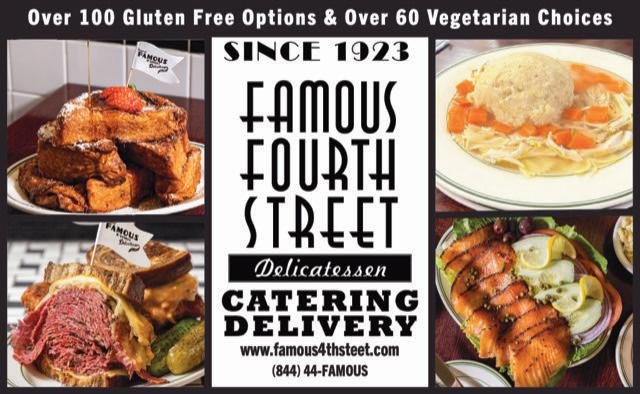
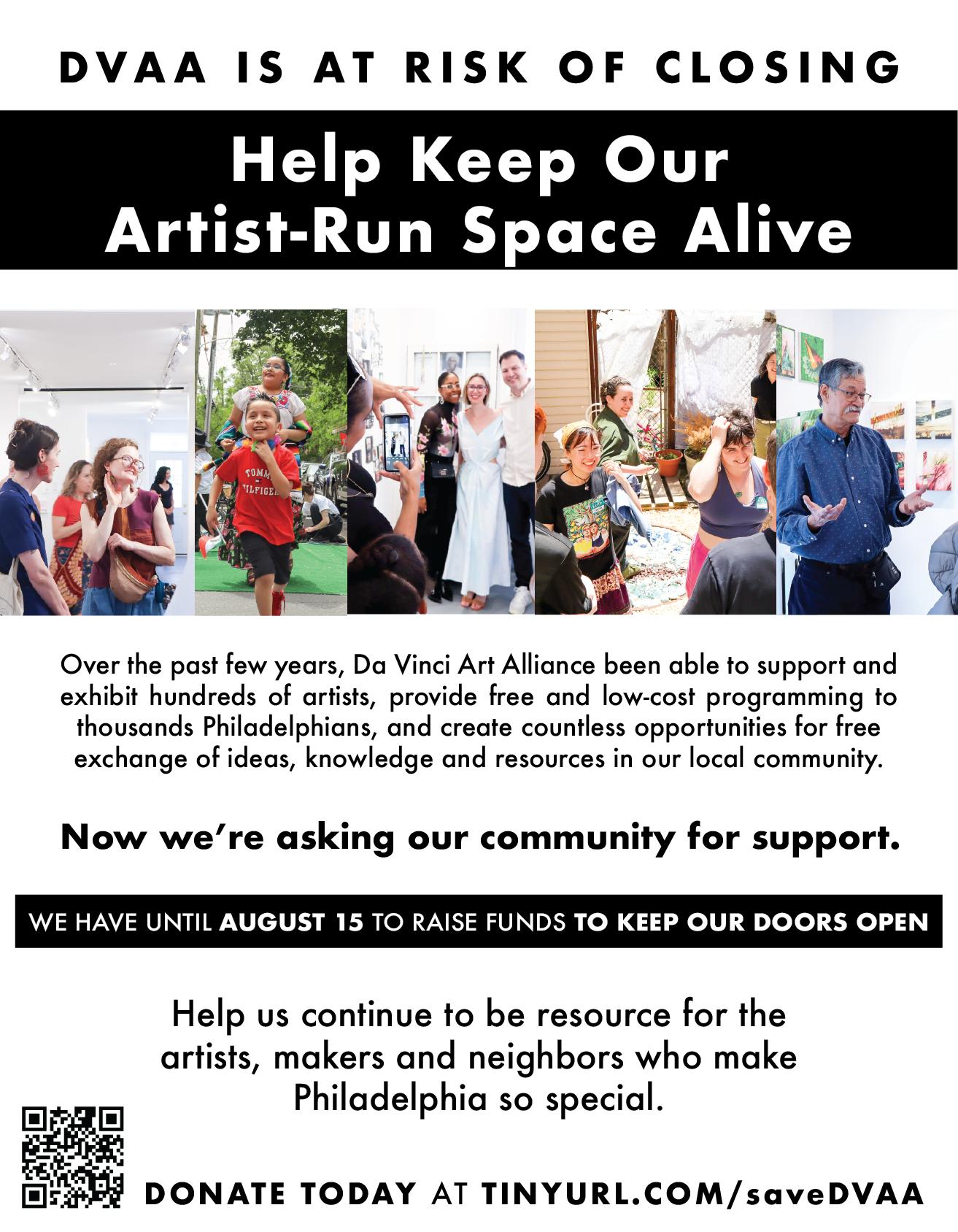

By Nicole Maley with photos by Maxine Mayer
There is a surplus of unique and dynamic personalities that call Queen Village home—and I don’t just mean our lovely neighbors. I’m talking about the houses, restaurants, businesses, art studios, and even the public spaces. They have a singular charm and identity that makes a stroll through the Village ever interesting. This is none more represented than in one of my favorite aspects of this neighborhood: its bookstores.
Queen Village is a literary lover’s dream. From the nonfiction novel to romantasy to travel, every possible genre has representation in one Village bookstore or another. You can find a wide selection of new and used books, sometimes within the same store. And if you are looking for a particular vibe or merely a place to hide out for a few hours with a good book, you will find it in this neighborhood.
With warm weather finally upon us, it felt like time for a neighborhood bookstore crawl to get my summer reading list in place. In the process, I was able to speak to the proprietors of a few of the local book nooks.
There is no wrong way to start this crawl, but I began in the northern gateway to Queen Village, Head House plaza, and popped into Head House Books, located at 619 S. 2nd Street. Opened in 2005, Head House Books has a strong connection to the neighborhood and its businesses, with proprietor Richard De Wyngaert living only a few blocks away in Society Hill.
“One of our absolute favorite things about Queen Village is farmers’ market Sundays,” says De Wyngaert. “We love seeing our regular customers with their bags filled with produce and flowers making their way down our aisles, finding their next read for the week.”
There is something so personalized about the experience at Head House Books. That relatability is reflected in its comfy reading chair in the front of the store and the mix of popular paperbacks, award-winning contemporary works, and classic novels by the greats, sometimes all within the same shelf. I spotted Ulysses by James Joyce right above prose from Barbara Kingsolver and summer yarns from Elin Hilderbrand, which deeply resonated with my own contradictory book taste. Make sure to check out the “Richard’s Recommendations” table right by the register and a little secret alcove next to the tarot & card games where you can find romances, mystery thrillers, and local Philly authors.
“We feel that there is something timeless about our space,” says De Wyngaert. “Our regular customers span generations and our selection focuses not just on what is popular at the moment, but books that make life better, sweeter, or even just more comprehensible.”
Head House Books is cooking up a number of fun summer events, including their monthly book club in collaboration with Bloomsday Cafe, a summer

Richard De Wyngaert (Head House Books):
Long Distance - “ the new short story collection from Aysegül Savas. We joke that we are the Philly fan club for Aysegül Savas. Our entire team loved her books White on White and The Anthropologists.”
Perspective(ss) - “Lauren Binet’s new novel takes place in 16th-century Renaissance Italy, filled with art, politics, murder, and lots of compelling twists. Great summer read!”
Noelle Egan (Brickbat Books):
“I’m going to recommend The Summer Book by Tove Jansson. A really engaging story of a young girl and her grandmother spending the Summer together on the bucolic coast of Finland.”
Joe Russakoff (Mostly Books):
“I recommend your readers come in and browse. They’ll find something.”
comedy night in August, and an event celebrating the inaugural class of the Jennifer Weiner Fellowship. (Weiner, whose books live in the secret alcove, is a New York Times best-selling author and Queen Village resident.)
For the next stop on the crawl, I headed over to Brickbat Books, located at 709 S. 4th Street on the legendary Fabric Row between Bainbridge and Monroe Streets. Founded in 2008 by Patrick Richardson Graham, Brickbat is designed with soothing brown tones and a shiny gold tiled ceiling that will give you the sense of being in a scholar’s private library. Brickbat prides itself on its collection of lesser-known contemporary literature and unique classic editions. I even found a bite-size copy of Tales of Army Life published in 1955 for my Tolstoy-obsessed husband.
“It’s a very pleasant space to spend time in, browse, and discover a peculiar little book,” says co-owner Noelle Egan, who has been involved with the shop since 2025.
“Peculiar little books” is one of my personal favorite genres, and I have found an excess of great ones here, including
multiple sci-fi Afro-futurist novels from Octavia Butler in the “Pulp” section and a colorful, kitschy copy of Jane Austen’s Persuasion from 1958. Brickbat’s thoughtfully curated selection has shelves focused on independent publishers (e.g., Atlas Press, Blank Forms, Exact Change), as well as an extensive collection of art and design books, fitting with its location on Fabric Row.
“We feel very lucky to be in Queen Village, particularly on Fabric Row, where we get to be surrounded by small-business owners who make and sell beautiful things and who care deeply about the neighborhood,” adds Egan.
One tip: Don’t forget to check out their children’s section in the front along with the highest shelves of the fiction section for some interesting copies of classics.
Two blocks away on Bainbridge between 5th and 6th Streets is our final stop, Mostly Books, located at 529 Bainbridge Street. Somehow its matter-of-fact name is both perfect and slightly incomplete. Other than the delightful collection of throwback DVDs, CDs, and VHS tapes at the entrance, the store is truly “mostly books.” But “mostly” means a lot of books. Spanning two floors and nearly half a block, Mostly Books is a stimulating, winding maze and the perfect place to get lost in on a summer afternoon. Owner, Joe Russakoff, opened the shop in 1997 as a response to the digital revolution and created a haven for those nonelectronically oriented in the process.
“Actual humans look at each book and decide if it’s interesting, and we don’t just don’t scan in the ISBN number to see where it fits in the Amazon algorithm,” he says. “We aren’t just a bricks-and-mortar version of an Amazon store.”
With its secluded reading corners and a section on nearly every subject imaginable, Mostly Books remains that haven


today even with screens owning our attention. As an (extremely) amateur historian, I am often perusing the wide selection of history books that pepper both the first and second floors, especially the semi-secret “World History” alcove where an interesting book can always be found (and where I bought something on my most recent outing). The store also has a fantastic travel section where relatively recent, high-quality Rick Steves and Fodor’s guides are less than $10.
DAMIS TEAM
BERKSHIRE Fox & Roach, HATHAWAY REALTORS' HomeServices

Gregory J. Damis, CNHS
With its overflowing shelves and Martin Luther King, Jr. cardboard cut-out greeting you, the zany controlled chaos of Mostly Books provides a different ambiance from some of the other neighborhood bookstores; but all local proprietors I spoke to for this crawl share the same love of the Village, including Russakoff.
“Queen Village is always evolving and always changing, yet it keeps the same cosmopolitan vibe,” adds Russakoff. “It was like a completely different neighbor-

• Experience
• Commitment
• Hard Work
• Enthusiasm
• Integrity
• Queen Village Resident
Serving Queen Village for 38 Years!
Our commitment to your happiness is the foundation from which a solid business relationship is built. Simply put, your satisfaction is our greatest reword. Our business hos been built on solid and unwavering foundations, and we look forward to putting our expertise to work for you.
Success Doesn't H a p p e n by Accident!
hood in the old days. My block had a lot of warehouses for Fabric Row and rooming houses and low rent apartments for working people. And there were artists and hippie types sprinkled in. I include myself in the last group.”
By now, you should have a nice mix of summer .reads, but the bookstore crawl doesn't need to end, as there are plenty more nearby options.
• Garland of Letters (527 South St.) has a wonderful and eclectic mix of books and other items for sale.
• Black and Nobel (422 South St.) features a wide array of books, DVDs, art, and events related to AfricanAmerican culture
• Atomic City Comics (638 South St.) is a must have for the graphic novel and manga enthusiasts.
• The landmark Philly Aids Thrift (710 S. 5th St.) has an extensive used book section upstairs.
• Wooden Shoe Books (704 South St.) features a quirky mix of reading and politically-focused materials.
• In the Italian Market, Molly’s Books and Records (1010 S. 9th St.) is a lively and stuffed used book store. (Fun fact: It’s run by Molly Russakoff, the sister of Mostly Books’ owner, Joe.)
• The iconic Book Trader in Old City (7 N. 2nd St.) is always worth a visit, especially to see its resident bookstore cat, Dr. Pickles. (Follow him on Instagram @thedrpicklesofbooktrader.) ■
By Maureen Brady Weir
Nothing beats spending late summer evenings enjoying the outdoors. But unfortunately, it also means dealing with mosquitoes. These unwelcome guests can quickly turn a relaxing evening into an itchy ordeal. While chemical repellent sprays and lotions can be effective, they often contain ingredients that you may want to avoid. The good news? There are simple, eco-friendly ways to keep mosquitoes at bay, letting you fully enjoy sitting on the front stoop with neighbors or joining in on backyard barbecues.
1. Choose Natural Repellents
Certain plants and essential oils naturally repel mosquitoes. Consider adding lavender, citronella, basil, or mint to your outdoor space. You can also use sprays made from essential oils like lemon eucalyptus or peppermint as a natural alternative to chemical repellents.
You can find a few of these plants at Cohen’s Hardware at 615 E. Passyunk Ave. For essential oils, Full Moon Blends at 617 S. 4th Street is a solid local go-to. At the time of this article, they’re searching for a new location in the neighborhood, but you can follow @fullmoonblends on Instagram for updates and pop-up spots.
Mosquitoes can lay eggs in even the tiniest pool of standing water, so it’s worth doing a quick check around your space.

Dump out puddles in flowerpot saucers, trash can lids, clogged gutters, or pet bowls. If you’ve got a rain barrel, keep it sealed with a tight lid or fine mesh screen. For fountains or other water features, make sure they drain properly or keep the water moving with a small pump.
A simple fan can make a huge difference as mosquitoes struggle to fly in strong a r currents. If you have safe access to an outlet, place a fan near your seating area. No power? Even a small, handheld battery-operated fan can offer some personal relief.
Mosquitoes are attracted to bright white light. Switching to yellow or LED bulbs can help minimize their presence. Consider using soft, warm lighting for ambiance while keeping the bugs away.
For an easy and natural mosquito repellent, try using whole cloves and citrus fruit. Simply stick cloves into an orange or lemon and place them on your outdoor table. The strong scent helps keep mosquitoes away. Another simple option is crushed garlic. Place crushed garlic around your seating area to create a natural barrier. (Plus, it’s rumored to keep vampires at bay too!) These methods are easy to implement and free of harsh chemicals.
Wearing light-colored, long-sleeved clothing can reduce bites, as mosquitoes are more attracted to dark colors. Opt for breathable, tightly woven fabrics that make it harder for mosquitoes to reach your skin.
Nature offers its own mosquito control. Birds, bats and dragonflies feed on mosquitoes. Consider installing a birdhouse or a bat box to help nature do its thing. Curious about adding a bat house to your space? Order a how-to book from Headhouse Books at headhousebooks.com to get started.
By taking a few simple steps, you can enjoy the final stretch of summer with fewer bites and bumps and a lot more fun. And by skipping the harsh chemicals, you’ll help keep your outdoor space more comfortable for everyone—except the mosquitoes. ■

By Dan Lidon
“One of the most interesting places in Philadelphia and probably the most generally skipped by sightseers is the emigration station, at the foot of Washington Avenue. After the arrival of every big ship, the big waiting room is a busy place. While the cabin passengers are hurrying into hacks or identifying bags and baggage, the steerage passengers are huddling into different corners of the big room, looking scared and frightened. There is a perfect babel of languages, from the brogue of the passengers who boarded at Queenstown, to the rapidly spoken words of the linguist from Siberia. French, Russian Hebrews, Poles, Germans, occasionally a passenger from Spain. These little groups have their picturesque and humorous
aspects, even romances are known to have originated in the humble surrounds of the emigration station. When, finally, the emigration train is announced, they all rush out like a flock of sheep, and the big station assumes a decidedly deserted appearance.” – The Philadelphia Inquirer, January 5, 1895.
130 years later, we are witness to a different kind of hectic and rushed atmosphere. Today, we experience the incessant traffic jams of commuters entering I-95, the string of cars waiting in the Dunkin’ Donuts drive-through, or our more active neighbors jogging on the riverfront bike path. It is fascinating to think that tens of thousands of Americans once took their first steps as citizens of this country on that same land.
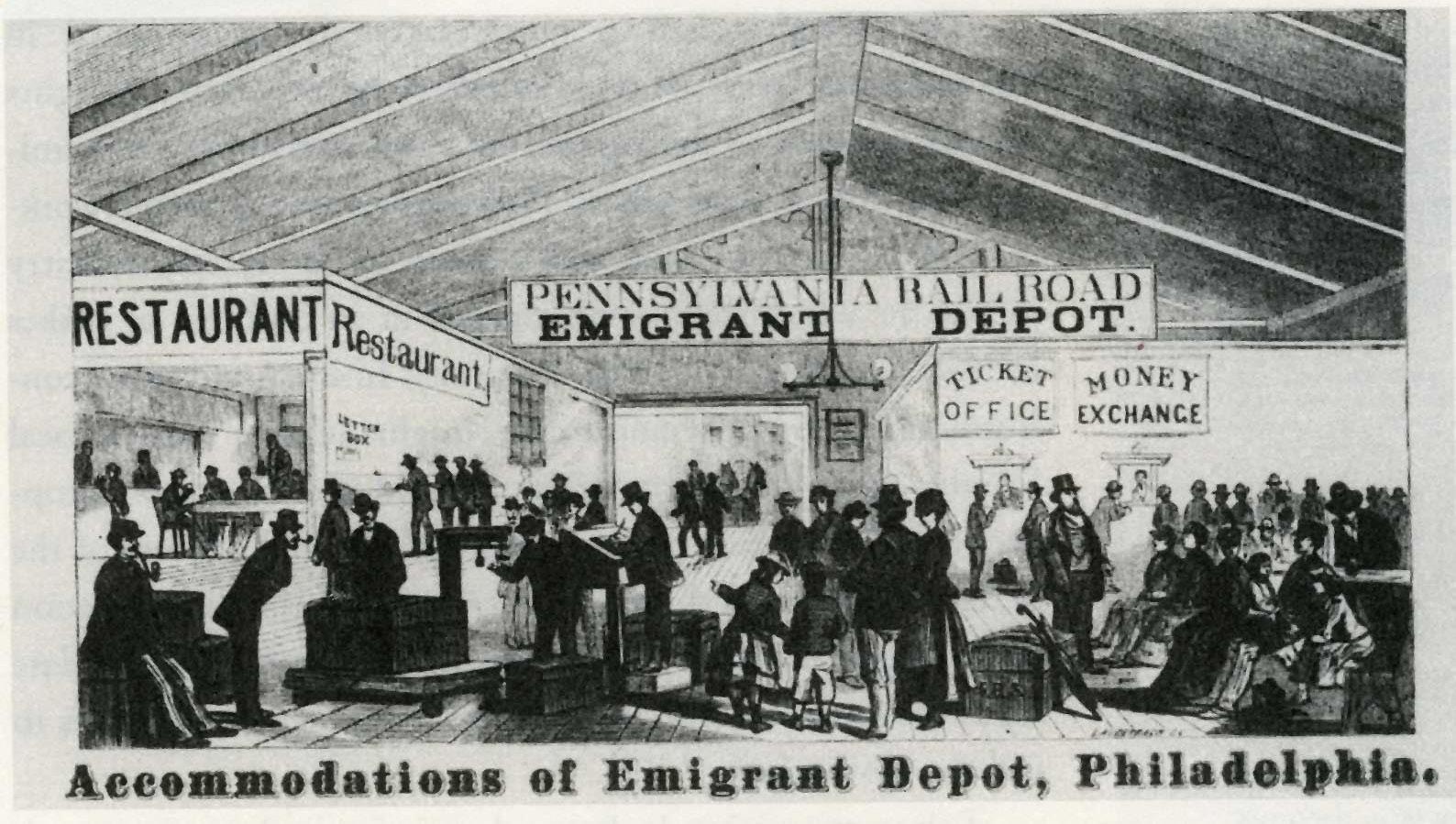
The area was designated by George Washington as a shipyard in the Naval Act, and by the late 1790s, it became official property of the United States Navy. During the early 1800s, the Southwark Yard played a vital role in national defense, producing warships throughout the 19th century. However, over time the facility became increasingly antiquated compared to newer naval bases of the era. In an 1861 opinion piece in The Philadelphia Inquirer, a reader states that the Southwark Navy Yard was underutilized in efforts to support the Union in the Civil War. By 1875, Aaron Augustus Sargent, chairman of the Committee on Naval Affairs, noted that the naval buildings needed about $319,000 in repairs, or approximately $9 million in today’s dollars. Congress soon followed his advice; the land was quickly sold off to private enterprise, and the funds were used to increase production at the League Island Navy Yard.
These private industries located at Washington and Delaware Avenues, particularly the Pennsylvania Railroad Company and various international shipping lines, rapidly expanded their operations with the property in their hands. This period of industrial growth coincided with a surge in immigration, creating a pressing need for a processing station in Philadelphia. In response, several of the existing

structures on the site were repurposed to meet this demand. Notably, one such building operated by the American-Red Star Line was adapted to serve as Philadelphia’s first official immigration station. Between 1873 and 1915, more than a million immigrants passed through our intersection of Washington Avenue and Columbus Boulevard.
It was not until the 1990s would the area see anything that resembled naval activity. In 2005, two smaller units of the U.S. Coast Guard joined to form the Sector Delaware Bay. The station provides many important safety duties for our modern shipping infrastructure, as well as keeping residents safe during any emergencies on the riverfront. While the station may not look old, it provides a critical piece linking our neighborhood to its rich maritime history.
The next time you’re waiting at the traffic light, take an extra second to look over and imagine the countless opportunities our waterfront has provided for millions of Americans both past and present. Before someone honks at you, of course. ■
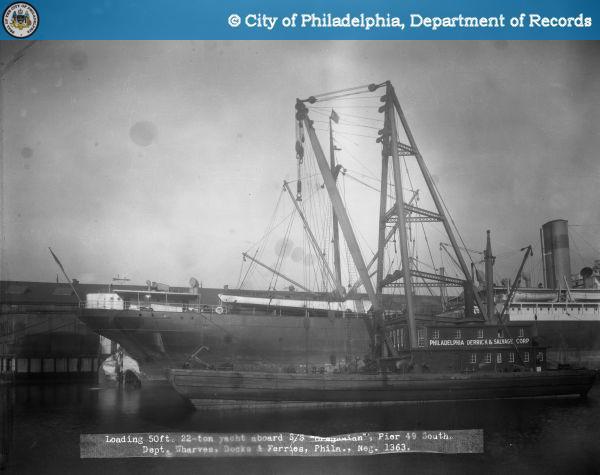

Photos by Maxine Mayer
Queen Village is a special place for many reasons. The surprising, beautiful, and eclectic mix of murals has to rank as one of our favorite things about the neighborhood! Please enjoy these photos of murals throughout our community and see if you can spot them on your walks throughout Queen Village. ■

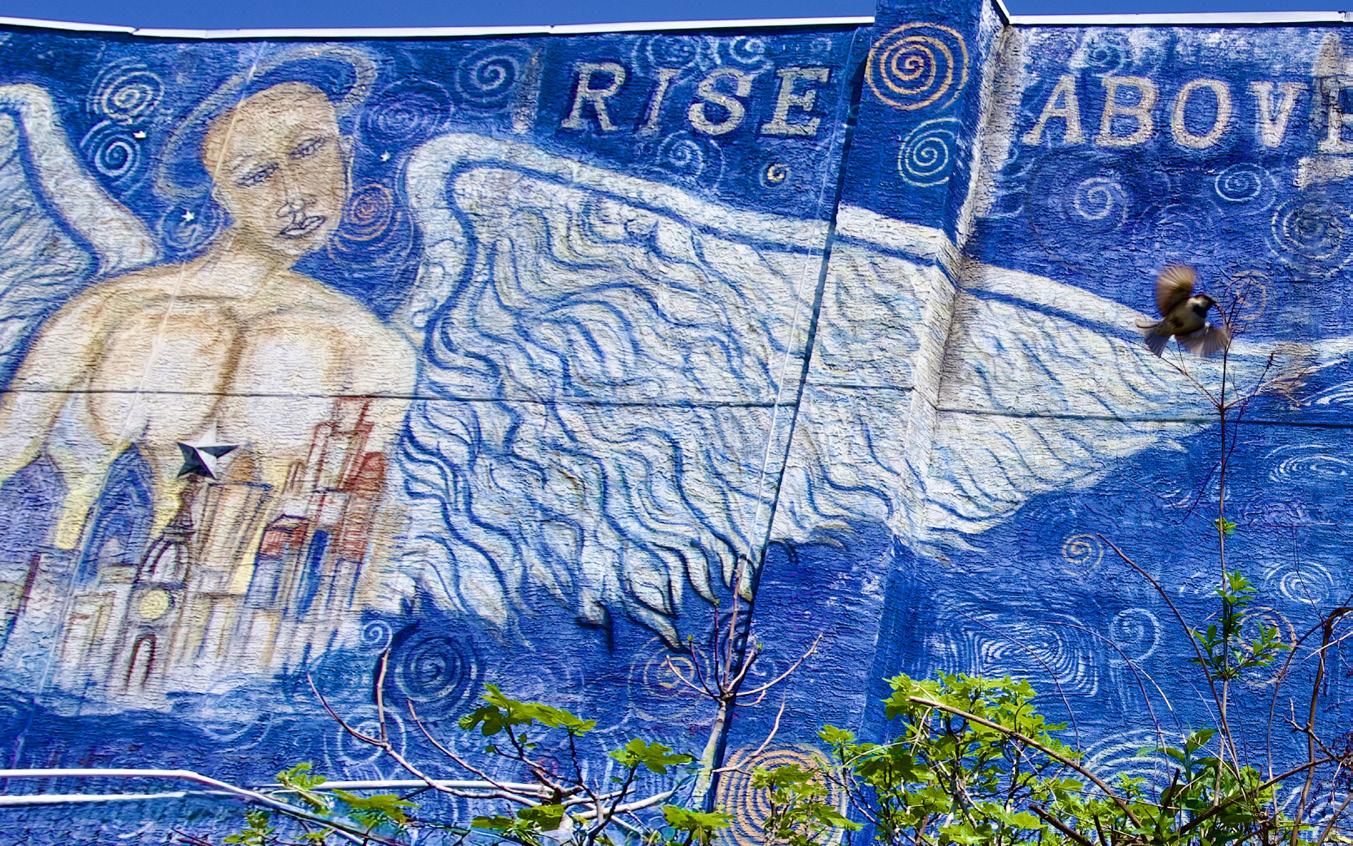



Story and photos by Jack Miller
On May 17, Queen Village was alive. Dog walkers were out in full force, the streets were crammed with cyclists taking advantage of the beautiful spring weather. The neighborhood was fuller than usual; music could be heard coming from 9th Street to mark the first day of Philly’s Italian Market Festival. By 10am, Theresa Kinsella, a member of the Friends of Beck Park group, already had her hands in the dirt. Beck Park, one of Queen Village’s often overlooked green spaces, resides on 2nd Street behind the new mixed-use apartment building on 2nd and Christian Streets. The park is an excellent spot for residents and newcomers alike as it provides a peaceful, shady public space to take in the early spring weather.
Beck Park was only one of several Queen Village parks that received springtime refurbishing this May as a part of the Love Your Park Week. The initiative, created by the Philadelphia Park Friends Network (PFN) organized clean-ups and beautification efforts for over 140 of Philadelphia’s public places. In addition to Beck Park, Mario Lanza, and Bainbridge Green also hosted volunteers to help our neighborhood parks shake off the effects of winter.
Kinsella spearheaded the work at Beck Park. She led a group of over 10 Queen Village residents focusing on picking up trash and removing dead plants. Volunteers also pruned some overhangs on the park’s evergreens and removed an invasive vine that was killing one of the main shade trees.
This year’s Love Your Park Week ran from May 10 to 18 and brought over 40
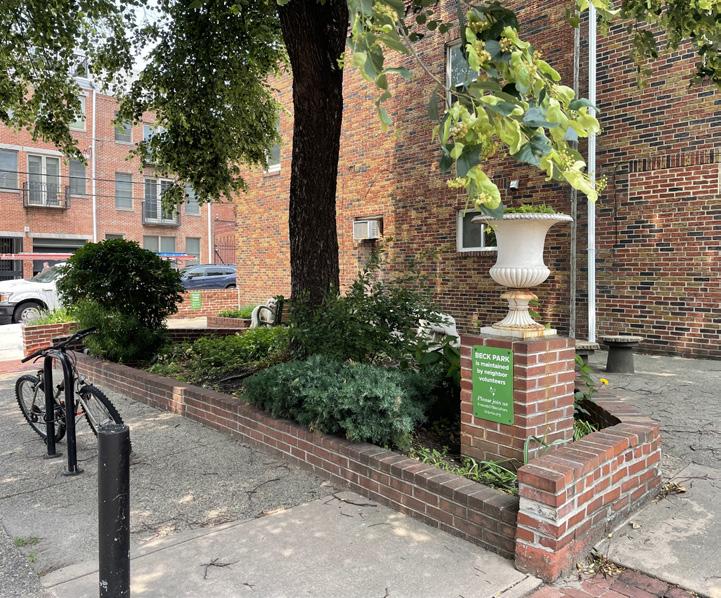
Queen Village volunteers focused on beautifying the neighborhood’s green spaces. This program is supported by the Fairmount Park Conservancy. Since the event’s inception in 2012, it has successfully centered the city’s public green spaces as areas of recreation, education, and community care. It is fair to say that many of the city’s parks we all enjoy today exist in their current state thanks to the efforts of PFN.
Mario Lanza Park received its yearly facelift a week prior to Beck Park. On the morning of May 10, Lisa Mell, along with other volunteers of the Friends of Mario
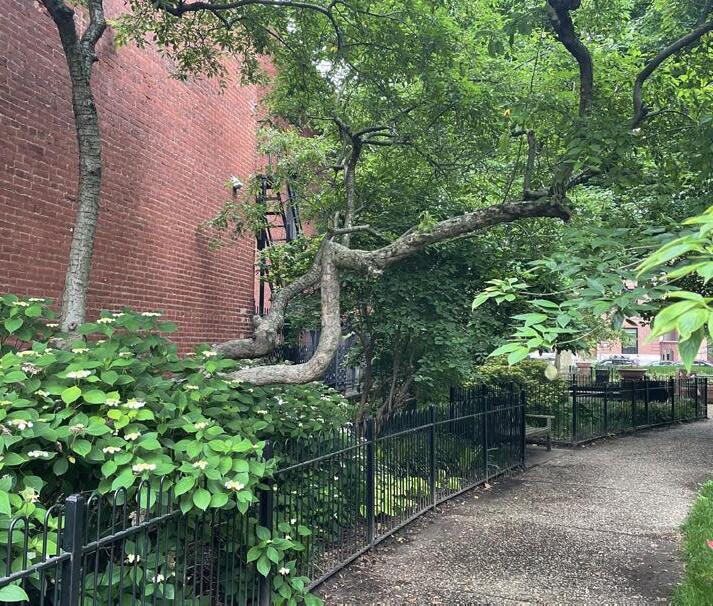
Lanza Park held the park’s annual “MulchFest”. The group mulched, planted new shrubs along the walkways, and trimmed some tree growth just in time for Kid Fest in June (Tuesdays throughout the month) As summer begins, please take some time during the sweltering days to relax and cool down in one of our beautiful parks and admire the hard work of our neighborhood volunteers! If you would like to get involved with a park group, visit the QVNA website (qvna.org) to learn more about Queen Village’s parks and see their various upcoming events. ■
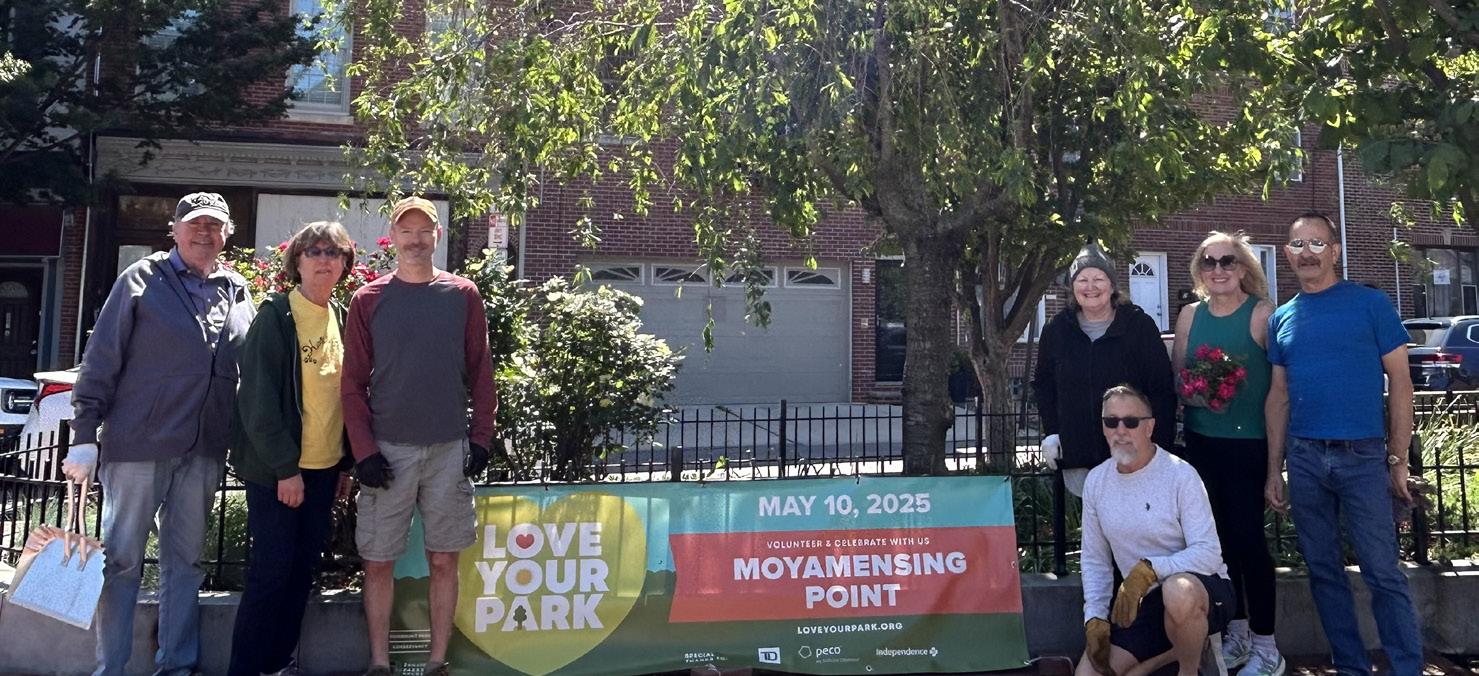

By Cait Allen
On May 3, QVNA hosted its third annual courtyard fundraiser/block party in conjunction with New Wave Cafe’s 40th anniversary celebration! From bouncy castles to barbecue and caricatures to raffle prizes, this year’s event was a huge success, with hundreds of neighbors and visitors coming to the block party. The fundraiser benefits children who live at the Courtyard housing development in the southern portion of Queen Village. Thanks to your generosity, we raised nearly $8,000 to help 30 students attend the 6-week program, filled with educational programming, fun field trips, and much more!
We hope to see you again next year. If you’d like to volunteer or be a vendor at next year’s event, please contact info@qvna.org. ■

By Louis Bartholomew
QV Tree Tenders volunteers braved the April cold to make sure 15 new saplings were planted and ready to bloom this spring in Queen Village! While our neighborhood has many wonderful trees (many thanks to the group and its wonderful leader, Dan Gibbon!), there are still many places that could use new street trees.
Why are trees important? The benefits of trees are numerous. They increase property values by bringing beauty and enhancing neighborhood character. They save energy, providing shade on the hottest of days, lowering temperatures by up to 9 degrees on city streets. They clean pollutants out of our air and water, while also acting as a buffer and reducing noise. Finally, they provide habitat for birds and other wildlife.
From QV Tree Tenders leader, Dan Gibbon: “I cannot think of a single better way to make a lasting improvement to the neighborhood we share than to add the pockets of green that trees provide.”
Over the summer, the group is focused on pruning existing trees and mulching new ones. Later in the fall, we will focus
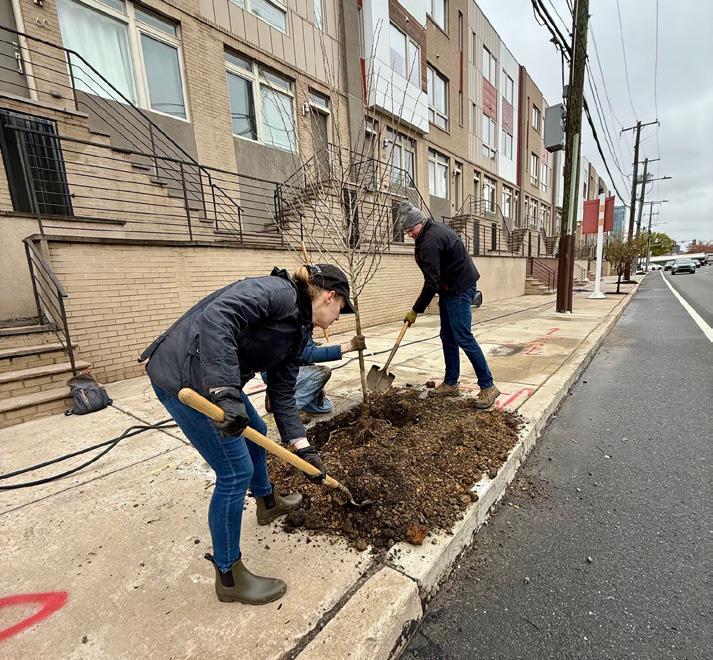

on encouraging neighbors to sign up for a street tree for planting in spring 2026. You can also check out our data collection efforts to map all existing empty tree pits and where new trees could go on our streets at qvna.org/qv-tree-tenders!
Want to sign up for a tree now? Check out phsonline.org/programs/tree-programs/
get-a-tree to learn more! The deadline is late November.
The next round of tree plantings will take place in fall 2025, and we are always looking for volunteers! If you’d like to volunteer with the QV Tree Tenders, please contact info@qvna.org to learn more and get involved. ■
















By Louis Bartholomew
Earlier this spring, QVNA hosted a meeting with representatives from the Delaware River Waterfront Corporation (DRWC), who shared their most recent plans and timetable for the Washington Avenue Connector Project.
This project will bring street safety upgrades to Washington Avenue from 4th Street to Columbus Boulevard, including repaving the road and adding dozens of new street trees, new ADAcompliant ramps and bump outs at intersections to decrease pedestrian crossing distances, a west-bound parking-protected bike lane on the north side, and a new multi-use trail for people walking and biking that will connect to the Delaware River Trail.
These upgrades prioritize street safety for all road users, ensuring that cars slow down and cause fewer crashes. Additional landscape investments, trees, raised planters, benches, and tables are planned for the public spaces at either end of the corridor. If you have any questions about the Washington Avenue Connector Project, email WAC@drwc.org. ■





Queen Village Restaurant Week!
July 18 to August 3 (excluding Saturdays)
Check out Queen Village’s inaugural Restaurant Week, highlighting over 20 area restaurants at $20, $40, and $60 price points! Go to qvna.org/restaurant-week for more details.
Yoga in the Park
Thursdays through September 25 at 6pm Jefferson Square Park
Join neighbors for relaxing yoga at Jefferson Square Park all summer long!
Mario at the Movies
Wednesdays in July, 8:30–10:30pm
Grab your friends, a comfy chair, and head to Mario Lanza Park for a summer movie night!
Fourth Fridays on South Street
Come to South Street every Fourth Friday for sidewalk sales, food and drink specials, live performances, art shows, popup shops, and much more!
Jefferson Square Park Cleanup
Saturday, August 9 from 9–11am
Calling all volunteers! Please help keep our parks clean by volunteering at the monthly Jefferson Square Park cleanups. It’s a great way to meet your neighbors and keep our green spaces beautiful!


